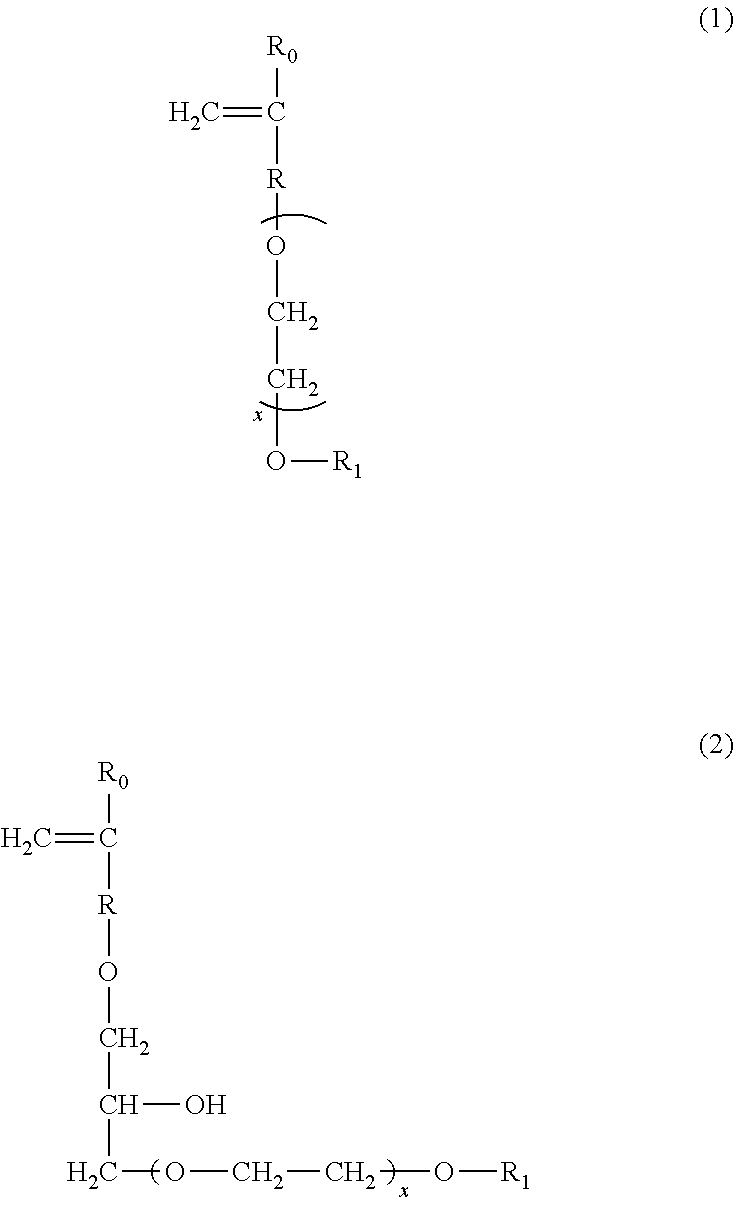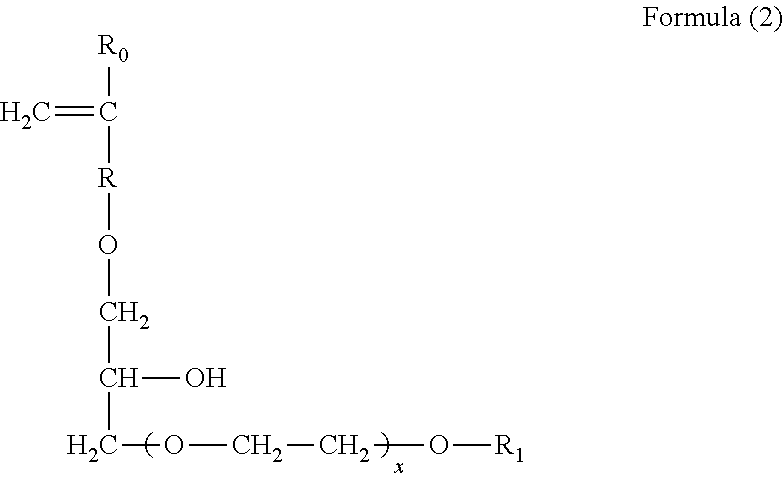Sulfonate group-containing copolymers and manufacturing method thereof
a technology of sulfonate group and copolymer, which is applied in the direction of detergent powder/flakes/sheets, detergent compounding agents, liquid soaps, etc., to achieve the effect of superior deposition inhibition ability and effective inhibition
- Summary
- Abstract
- Description
- Claims
- Application Information
AI Technical Summary
Benefits of technology
Problems solved by technology
Method used
Image
Examples
application example 1
[0153]To a glass separable flask of 1000-mL volume equipped with a reflux condenser and stirrer (paddle fins), 55.0 g of pure water and 0.0122 g of Mohr's salt were added and, while stirring, the temperature was raised to 90° C., and [this] was used as the polymerization reaction system. Next, while stirring, 200.0 g of 80% aqueous acrylic acid solution (also called “80% AA” below), 9.3 g of 48% aqueous sodium hydroxide solution (also called “48% NaOH” below), 75.0 g of 40% aqueous sodium 3-allyloxy-2-hydroxypropane sulfonate solution (also called “40% HAPS” below), 10.0 g of Monomer 1, 47.6 g of 15% aqueous sodium persulfate solution (also called “15% NaPS” below) and 34.0 g of 35% aqueous sodium hydrogen sulfite solution (also called “35% SBS” below) were added dropwise from separate nozzles to the polymerization reaction system maintained at 90° C. Dropwise addition times for the respective solutions were 180 min for 80% AA and 48% NaOH, 120 min for 40% HAPS and Monomer 1, 190 mi...
application example 2
[0156]To a glass separable flask of 1000-mL volume equipped with reflux condenser and stirrer (paddle fins), 69.0 g of pure water, 30.0 g of Monomer 1 and 0.0121 g of Mohr's salt were added and, while stirring, the temperature was raised to 90° C., and [this] was used as the polymerization reaction system. Next, while stirring, 175.0 g of 80% AA, 8.1 g of 48% NaOH, 75.0 g of 40% HAPS, 42.9 g of 15% NaPS and 42.9 g of 35% SBS were added dropwise from separate nozzles to the polymerization reaction system maintained at 90° C. Dropwise addition times for the respective solutions were 180 min for 80% AA and 48% NaOH, 120 min for 40% HAPS, 190 min for 15% NaPS and 175 min for 35% SBS. The dropwise addition rate for the various solutions was constant, and dropwise addition of the various solutions was performed continuously.
[0157]After completion of the 80% AA dropwise addition, the above reaction solution was maintained (cured) at 90° C. for another 30 min, and polymerization was complet...
application example 3
[0160]To a glass separable flask of 1000-mL volume equipped with reflux condenser and stirrer (paddle fins), 57.0 g of pure water and 0.0178 g of Mohr's salt were added and, while stirring, the temperature was raised to 90° C., and [this] was used as the polymerization reaction system. Next, while stirring, 225.0 g of 80% AA, 10.4 g of 48% NaOH, 225.0 g of 40% HAPS, 30.0 g of Monomer 2, 61.4 g of 15% NaPS and 70.2 g of 35% SBS were added dropwise from separate nozzles to the polymerization reaction system maintained at 90° C. Dropwise addition times for the respective solutions were 180 min for 80% AA and 48% NaOH, 120 min for 40% HAPS and Monomer 2, 190 min for 15% NaPS and 175 min for 35% SBS. The dropwise addition rate for the various solutions was constant, and dropwise addition of the various solutions was performed continuously.
[0161]After completion of the 80% AA dropwise addition, the above reaction solution was maintained (cured) at 90° C. for another 30 min, and polymeriza...
PUM
| Property | Measurement | Unit |
|---|---|---|
| mass % | aaaaa | aaaaa |
| mass % | aaaaa | aaaaa |
| mass % | aaaaa | aaaaa |
Abstract
Description
Claims
Application Information
 Login to View More
Login to View More - R&D
- Intellectual Property
- Life Sciences
- Materials
- Tech Scout
- Unparalleled Data Quality
- Higher Quality Content
- 60% Fewer Hallucinations
Browse by: Latest US Patents, China's latest patents, Technical Efficacy Thesaurus, Application Domain, Technology Topic, Popular Technical Reports.
© 2025 PatSnap. All rights reserved.Legal|Privacy policy|Modern Slavery Act Transparency Statement|Sitemap|About US| Contact US: help@patsnap.com



